Last updated on
Discover the ideal frequency for maintaining a pristine couch by understanding the factors that contribute to its cleanliness and longevity.
Your couch is the centerpiece of your living room – it’s where you relax after a long day, host movie nights with friends, and cuddle up with loved ones. But how often do you clean it? It’s easy to forget that our beloved couches need regular cleaning too.
From crumbs and pet hair to spills and stains, there are plenty of reasons why we should be giving our couches a little TLC. In this article, we’ll explore just how often you should be cleaning your couch to keep it looking and feeling its best for years to come.
So grab a cozy blanket, settle into your favorite spot on the sofa, and let’s get started!
Table of Contents
Importance of Cleaning a Couch
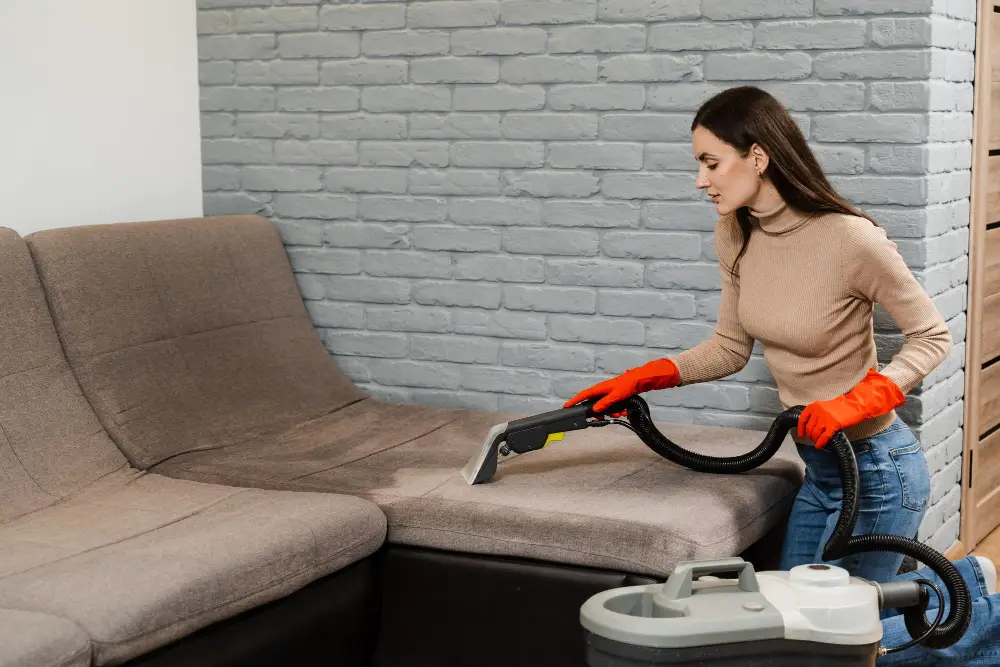
Your couch is more than just a piece of furniture – it’s an investment in your home and comfort. Regular cleaning not only keeps it looking great, but also extends its lifespan.
Dirt, dust, and debris can accumulate on the surface of your couch over time, leading to wear and tear that can be costly to repair or replace. Neglecting to clean spills or stains immediately can cause them to set in permanently.
But beyond aesthetics and maintenance costs lies another important reason for keeping your couch clean: health concerns. Your sofa is a prime spot for bacteria growth due to frequent use by family members or guests who may carry germs with them from outside sources such as work/school environments.
Moreover pets are known carriers of allergens which could lead people with allergies into discomfort if they sit on dirty sofas.
By regularly cleaning your couch you’re reducing the risk of illness-causing bacteria spreading throughout the household while ensuring everyone has access to a comfortable seating area free from dirt buildup that could trigger allergies.
Signs Your Couch Needs Cleaning
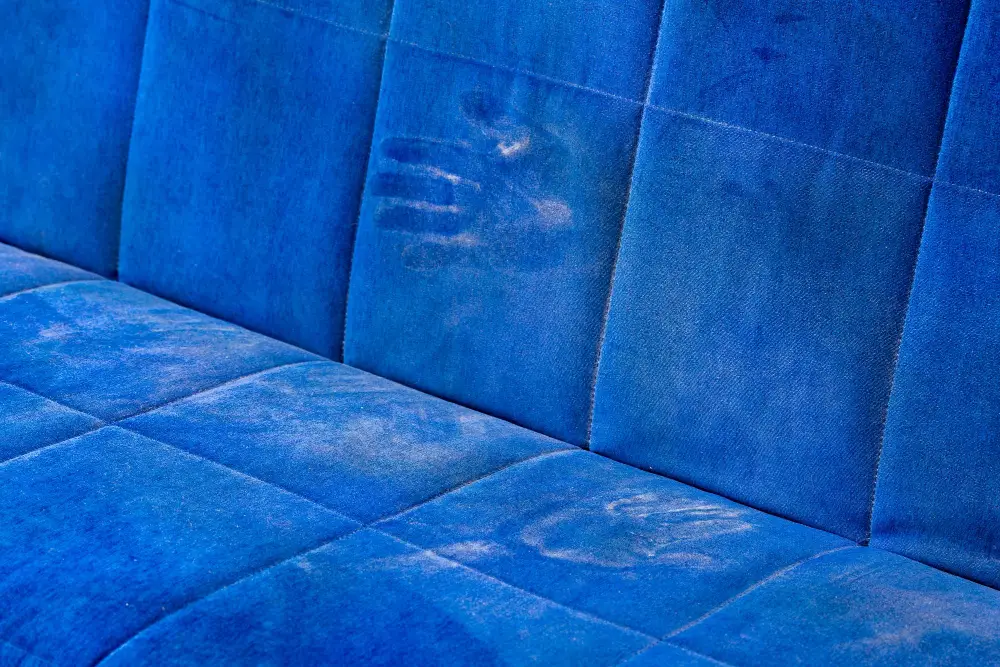
There are some telltale signs that indicate it’s time to give your sofa a good scrubbing. One of the most obvious signs is visible stains or spills on the upholstery.
If you notice any discoloration or spots on your couch, it’s important to address them as soon as possible before they become more difficult to remove.
Another sign that indicates a need for cleaning is an unpleasant odor emanating from the cushions or fabric of your couch. This can be caused by pet hair and dander, food crumbs and spills, sweat and body oils from regular use – all of which can accumulate over time.
If you have allergies or respiratory issues such as asthma, then dust mites may also be present in your furniture causing discomfort when sitting down on them. Lastly but not leastly; if you haven’t cleaned up after pets who shed fur regularly like cats & dogs then their hair will start accumulating in crevices making things worse than ever before!
Factors Affecting Cleaning Intervals
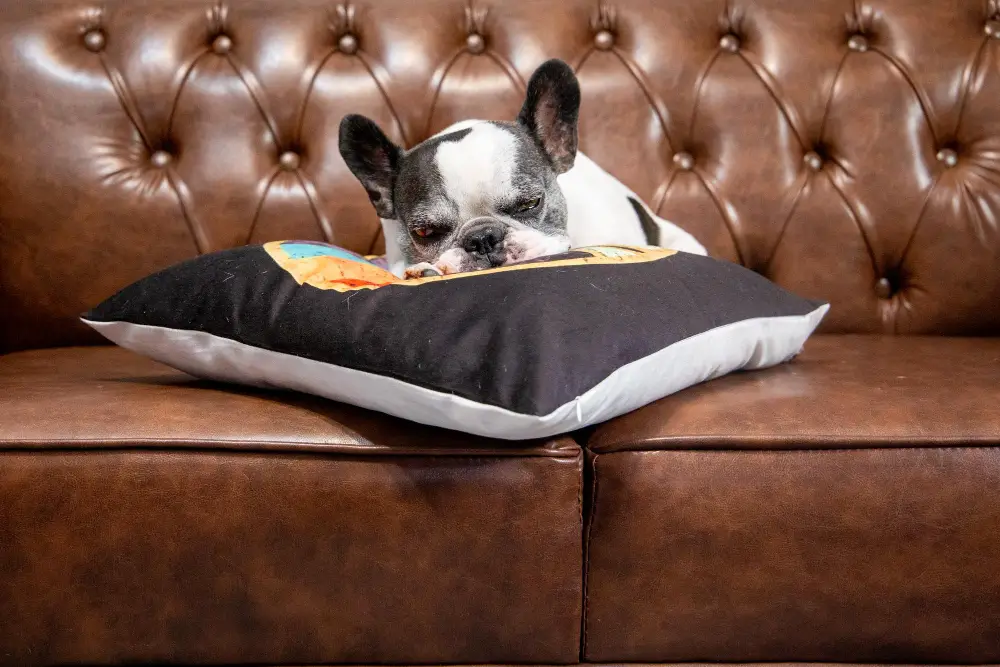
The frequency of use, the number of people and pets in your household, and the type of upholstery are all important considerations. If you have a busy household with kids or pets who spend a lot of time on the couch, it’s likely that you’ll need to clean it more frequently than if you live alone or rarely use your sofa.
The material used for upholstery is also an essential factor to consider when determining cleaning intervals. Some fabrics like microfiber and leather require less frequent cleaning compared to cotton or linen materials that tend to attract dust easily.
Another critical aspect is whether anyone in your home has allergies or respiratory issues as dirty furniture can exacerbate these conditions. In such cases, regular vacuuming and deep-cleaning may be necessary.
Cleaning Frequency Recommendations

As a general rule of thumb, experts recommend vacuuming and dusting your couch at least once a week to remove any surface dirt or debris that may accumulate. This will help prevent stains from setting into the fabric.
For households with pets or young children who spend more time on the couch than adults do, it’s recommended to clean their furniture every three months thoroughly. For those without kids but still want to maintain their sofa’s cleanliness regularly should consider deep-cleaning twice per year.
However, suppose someone in your home suffers from allergies such as asthma; In that case,it is best practice for them always to keep up with regular cleaning schedules by vacuuming weekly and deep-cleaning every two months.
Vacuuming and Dusting Frequency
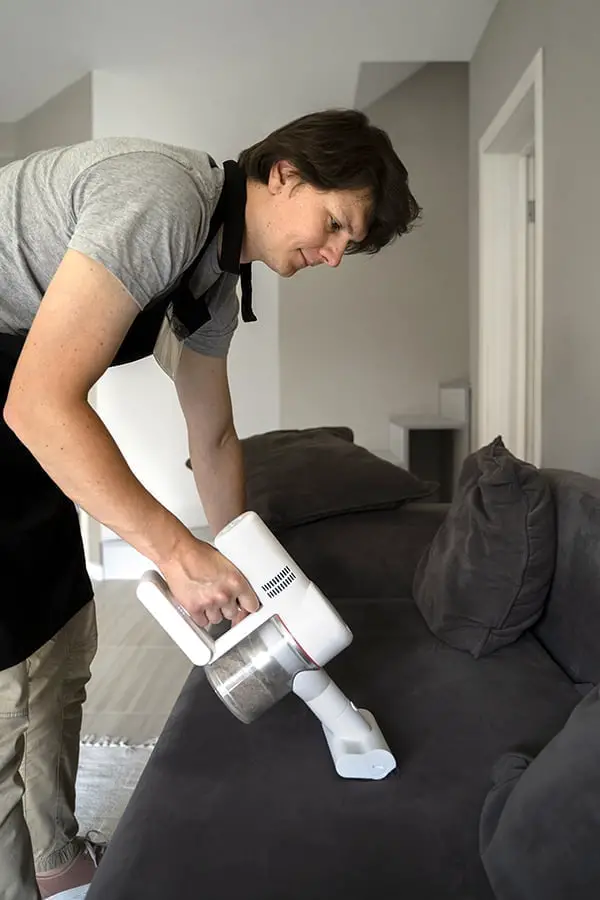
This helps remove dirt, dust, pet hair, and other debris that can accumulate on the surface of your couch over time. But how often should you be doing this?
The frequency at which you should vacuum or dust your couch depends on a few factors such as usage level, household members (including pets), location in the house (indoor/outdoor), among others.
For instance, if you have kids who love snacking while watching TV or pets that shed frequently around/on the sofa; then more frequent cleaning will be necessary.
As a general rule of thumb though: aim to vacuum/dust at least once every two weeks for moderate use sofas. If there are no visible signs of dirt accumulation after two weeks – extend it up to four weeks before another round.
Dealing With Stains and Spills
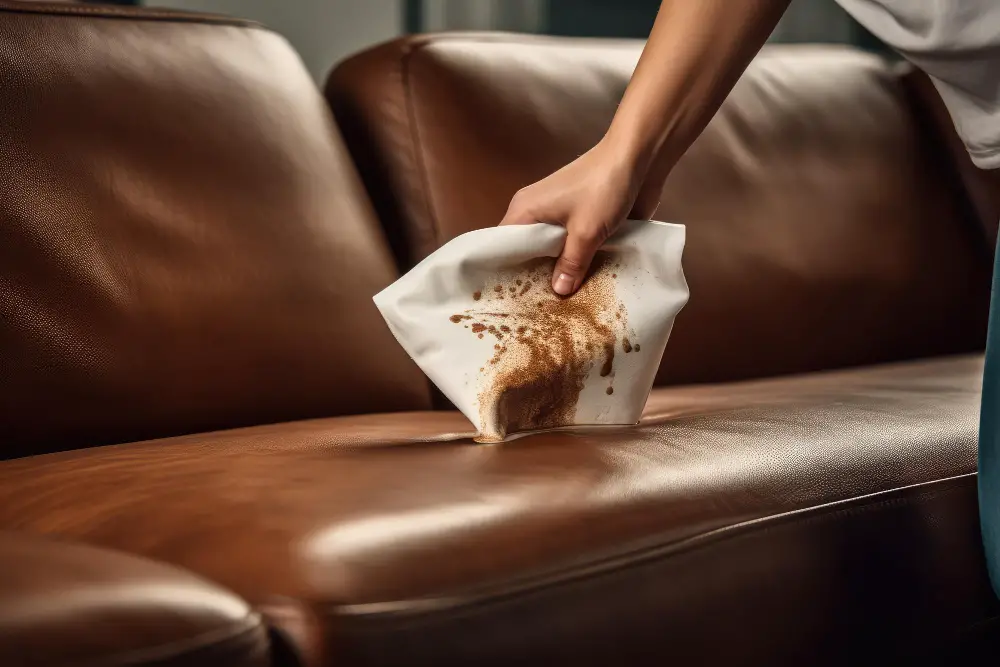
Whether it’s a glass of red wine or a smear of chocolate, stains can be tough to remove if not dealt with promptly. The key is to act fast – the longer you wait, the harder it will be to get rid of the stain.
For liquid spills like coffee or juice, start by blotting up as much as possible using a clean cloth or paper towel. Avoid rubbing at all costs since this can spread the stain further into your upholstery fibers.
For solid substances like food crumbs or makeup smudges on your couch cushions, use a soft-bristled brush attachment on your vacuum cleaner for easy removal.
If you’re dealing with an oil-based spill such as grease from pizza slices that have fallen onto your sofa cushion covers; sprinkle some baking soda over them before brushing off any excess powder after 15 minutes using another clean cloth dampened in warm water mixed with dish soap solution (1 tablespoon per cup).
Deep Cleaning Schedules

Deep cleaning involves removing all the cushions and thoroughly washing or steam-cleaning the upholstery fabric. This process helps remove any dirt, dust mites, allergens, or stains that may have accumulated over time.
The frequency of deep cleaning depends on how often you use your couch and whether you have pets or children who spend a lot of time on it. As a general rule of thumb, aim to deep clean your couch at least once every 12-18 months.
If you’re not sure where to start with deep cleaning your couch yourself, consider hiring professional upholstery cleaners who specialize in this type of service. They’ll be able to assess the condition of your sofa and recommend an appropriate treatment plan based on its material type.
Couch Maintenance Tips
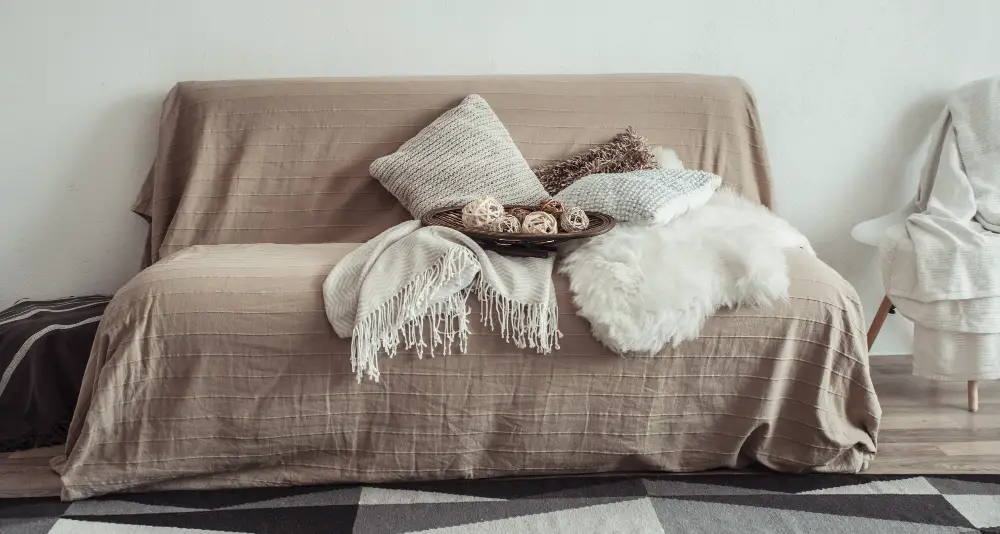
One easy way to maintain the shape of your cushions is by flipping them regularly. This will help prevent sagging and uneven wear over time.
Another important tip is to avoid placing heavy objects on your couch, as this can cause damage or leave permanent indentations in the upholstery. If you have pets that like to snuggle up on the sofa with you, consider using a protective cover or throw blanket to keep their fur from embedding itself into the fabric.
Be mindful of where you place your couch in relation to direct sunlight and heat sources such as radiators or fireplaces. Overexposure can cause fading and discoloration over time.
Preventing Odors and Allergens
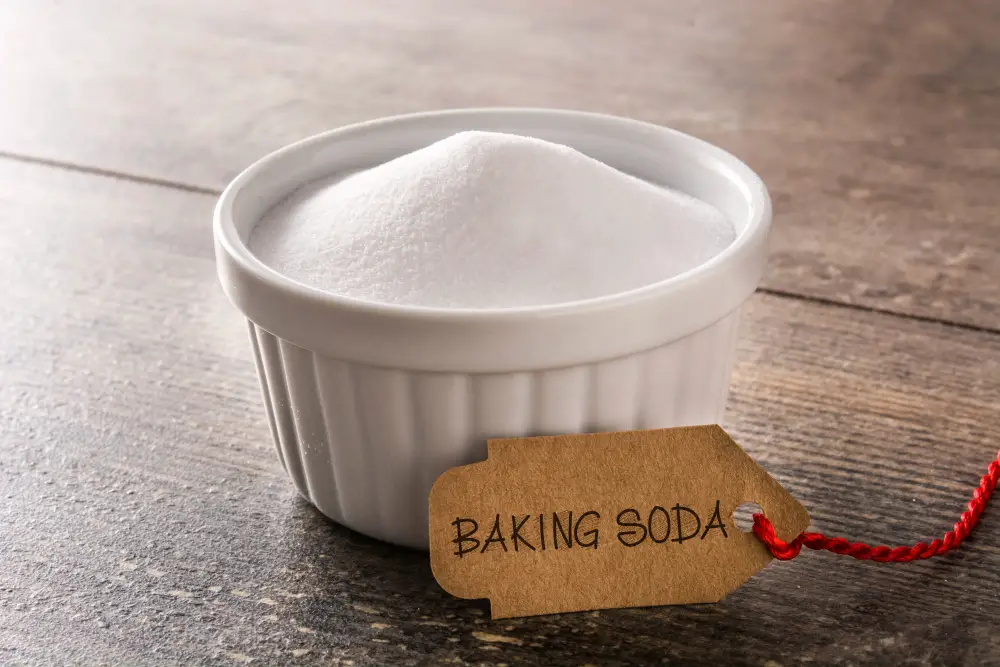
These odors not only make your living space less inviting but can also trigger allergies or respiratory problems. To prevent these issues, it’s important to take steps to keep your couch smelling fresh and clean.
One way is by using baking soda as a natural deodorizer. Simply sprinkle some on the surface of the couch, let it sit for 15-20 minutes, then vacuum it up with an upholstery attachment.
Another effective method is using essential oils in a diffuser or spray bottle diluted with water. Lavender oil has antibacterial properties that help eliminate odor-causing bacteria while providing a calming scent.
To reduce allergens such as dust mites and pollen on your couch cushions, consider investing in hypoallergenic covers that are easy to remove and wash regularly at high temperatures (above 130°F). Vacuuming frequently will help remove any accumulated dust particles before they become problematic for allergy sufferers.
Cleaning Couches With Children

From sticky fingers and spilled drinks to muddy shoes and crayon marks, kids can wreak havoc on a sofa in no time. To keep your couch looking its best when little ones are around, it’s important to clean it regularly.
Vacuuming the cushions at least once a week will help remove crumbs, dirt or pet hair that may accumulate over time. If there are any spills or stains from food or drink accidents (which we all know happen), act quickly by blotting up as much of the liquid as possible with paper towels before applying an appropriate cleaning solution.
For fabric upholstery materials such as cotton blends or microfiber sofas that can’t be removed for washing purposes; use mild soap mixed with water instead of harsh chemicals like bleach which could damage the material fibers over time.
Couch Cleaning for Pet Owners
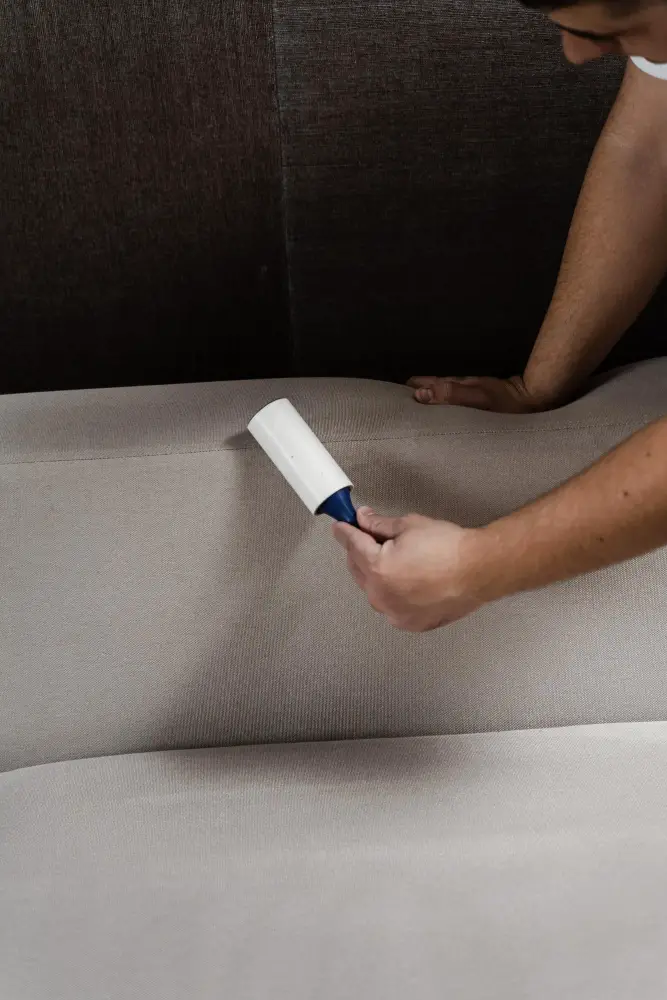
Pet hair, dander, and odors are just a few of the challenges that pet owners face when it comes to keeping their furniture clean. If you’re a pet owner, it’s important to take extra care in maintaining your couch so that both you and your pets can enjoy its comfort.
One of the best ways to keep your couch clean is by regularly vacuuming up any loose fur or debris with an upholstery attachment. You may also want to invest in a lint roller or sticky tape for quick touch-ups between deep cleans.
If your pet has had an accident on the couch, act quickly by blotting up any excess liquid with paper towels before treating the stain with an enzymatic cleaner designed specifically for pet messes. Avoid using harsh chemicals or steam cleaners which could damage delicate fabrics.
To prevent future accidents from happening altogether consider training your pets not to jump onto furniture unless invited and provide them with comfortable beds nearby where they can rest instead.
Upholstery Material Guide
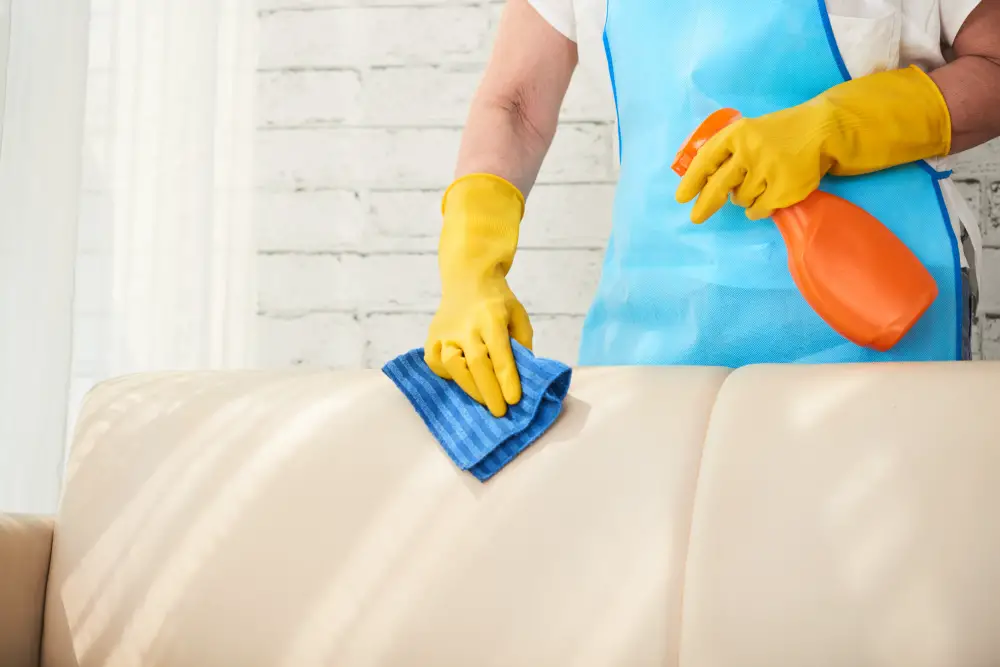
Different materials require different cleaning methods and schedules to maintain their appearance and durability. Here are some common upholstery materials you may encounter, along with tips on how to care for them:
– Leather: Leather couches are durable, but they need regular maintenance to keep them looking good. Wipe down the surface regularly with a damp cloth or use leather cleaner specifically designed for this purpose.
– Microfiber: This synthetic fabric is popular because it’s easy to clean and resistant to stains. Vacuuming once a week should suffice, but if there’s any spillage or staining, use mild soap mixed with water.
– Cotton: Cotton is soft and comfortable but can be prone to staining easily due its absorbent nature; hence vacuuming weekly followed by spot-cleaning as needed will help keep cotton sofas clean.
– Linen: Linen has an elegant look that adds sophistication in any room; however, it requires more attention than other fabrics since spills can leave permanent marks on linen fibers – so avoid eating/drinking near these types of sofas!
Caring for Leather Couches
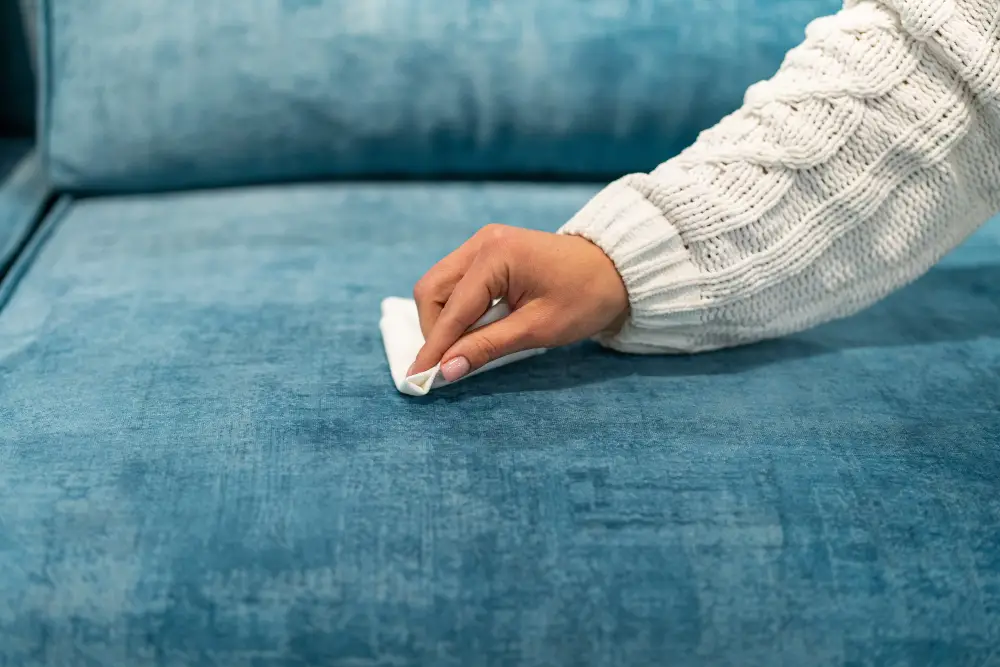
Unlike fabric upholstery, leather is more sensitive to spills and stains, making it important to clean up messes as soon as possible. To keep your leather couch looking its best for years to come, follow these tips:
1. Dust regularly: Use a soft cloth or vacuum with an upholstery attachment once a week.
2. Clean spills immediately: Blot the spill with a dry cloth or paper towel until all moisture is absorbed.
3. Avoid harsh chemicals: Only use cleaning products specifically designed for leather furniture.
4. Keep away from direct sunlight and heat sources: Leather can fade and crack when exposed too long in direct sunlight or near heat sources like radiators or fireplaces.
5. Protect against scratches by pets/kids: Place scratch-resistant covers on areas where pets/kids frequently sit/lay down.
Outdoor Furniture Cushions Maintenance

Sun, rain, and wind can all take a toll on your outdoor cushions over time. To keep them looking their best for as long as possible, there are a few things you can do.
Firstly, invest in high-quality outdoor furniture covers that will protect your cushions from the sun’s harmful UV rays and other weather conditions. When not in use or during extended periods of inclement weather such as heavy rain or snowfall cover up your patio set with these covers.
Secondly, regularly brush off any dirt or debris that accumulates on the surface of the cushion using a soft-bristled brush before washing them down with mild soap and water solution (1/4 cup dishwashing liquid mixed into 1 gallon of warm water). Rinse thoroughly with clean water afterward.
Lastly store away any removable cushion inserts indoors during winter months if possible so they don’t get damaged by freezing temperatures.
Upholstery Cleaning Codes Explained

Most manufacturers attach a tag with a code that indicates how to clean the fabric or leather without damaging it. These codes are typically represented by letters and can be found under cushions or on the bottom of your couch.
“W” stands for water-based cleaners, “S” means solvent-based cleaners only, “WS” allows both types of cleaning solutions while “X” requires professional cleaning only. It’s important to follow these codes as using improper products can cause permanent damage and void any warranty you may have.
If you’re unsure about what type of cleaner is safe for your couch, test it in an inconspicuous area first before applying it all over. Remember that prevention is key – avoid eating messy foods on your sofa and keep pets off if possible.
Determining Cleaning Schedule
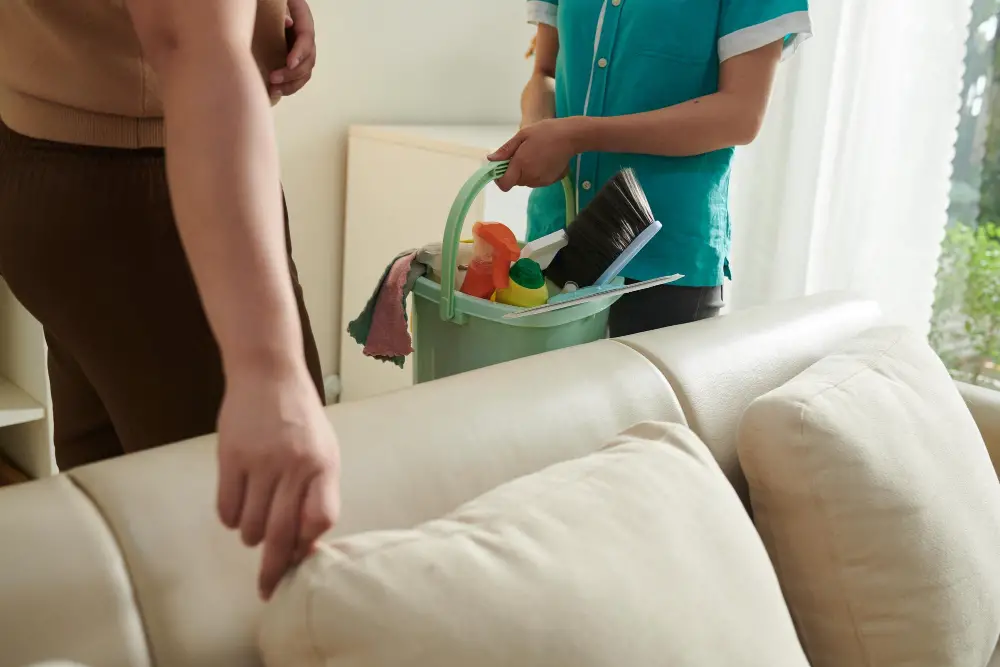
The frequency of cleaning will depend on several factors such as usage, household members, and pets. If you have a busy household with kids and pets who frequently use the couch or if someone in your family has allergies or respiratory issues, then more frequent cleanings may be necessary.
On average, experts recommend deep-cleaning upholstered furniture at least once every 12-18 months for normal use. However, if there are spills or stains that occur regularly on your couches due to children or pets’ activities – then it is best to clean them immediately before they become permanent marks.
It’s also important to note that different types of upholstery materials require varying levels of care and maintenance. For example: leather sofas need less frequent cleaning than fabric ones because they don’t absorb liquids as quickly; outdoor cushions exposed to weather elements may require more regular attention than indoor ones.
Sofa Cleaning Tips and Techniques
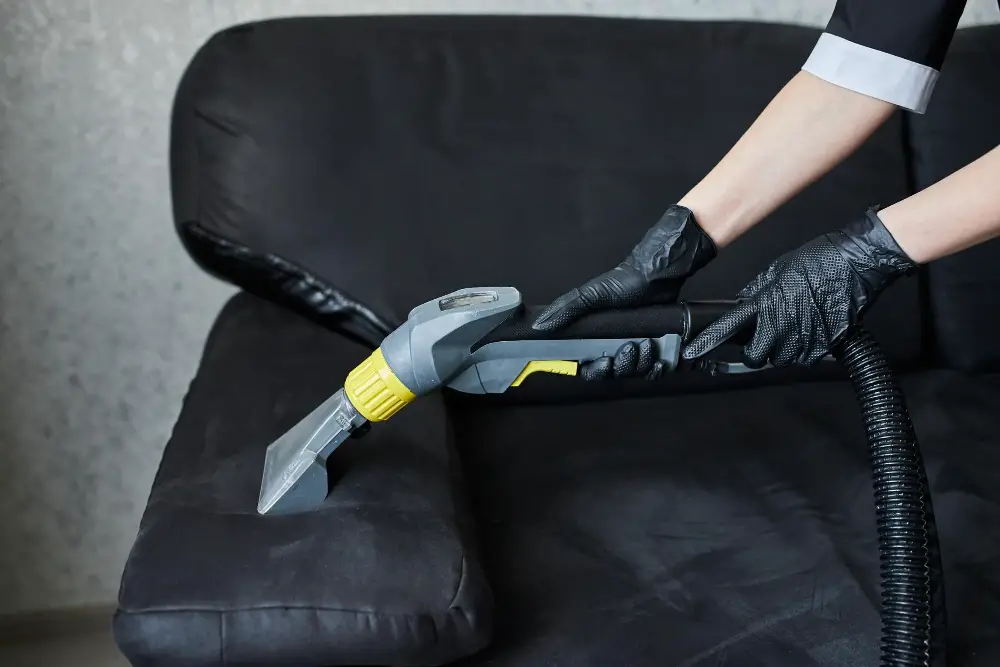
First, always check the manufacturer’s instructions for any specific cleaning recommendations or restrictions based on your sofa’s material.
For general maintenance, vacuuming is key to removing dirt, dust, pet hair and other debris from deep within the fibers of your couch. Use a soft brush attachment to avoid damaging delicate fabrics.
If you’re dealing with stains or spills on upholstery fabric sofas (excluding leather), start by blotting up as much of the liquid as possible with a clean cloth or paper towel before applying any cleaners. Avoid rubbing which can spread stains further into fabric fibers.
For spot-cleaning small areas of upholstery fabric sofas (again excluding leather), mix one teaspoon dish soap in one cup warm water then dip a clean white cloth into this solution before gently dabbing onto stain until removed.
DIY Vs Professional Cleaning
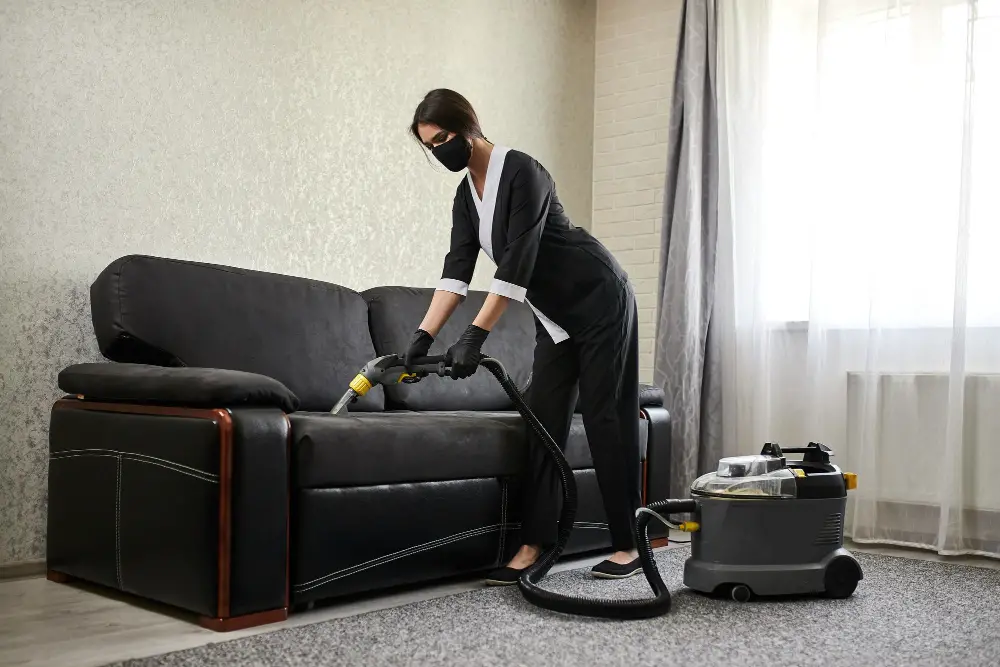
While both methods can be effective, there are some key differences to consider.
DIY cleaning involves using household products and tools such as baking soda, vinegar, and a vacuum cleaner. This method is cost-effective and convenient since you can do it on your own time without having to schedule an appointment with a professional cleaner.
However, DIY methods may not always be the best option for tough stains or deep-seated dirt that requires specialized equipment. If done incorrectly or with the wrong products/tools/methods for your specific upholstery material type (which we will discuss later in this article), DIY attempts could lead to further damage of the fabric.
Professional cleaners use industrial-grade equipment and specialized techniques that are designed specifically for upholstery materials like yours. They also have experience dealing with various types of stains/spills/odors/allergens etc., so they know how best to tackle each situation effectively while minimizing any potential damage risks.
Cleaning Professional Services
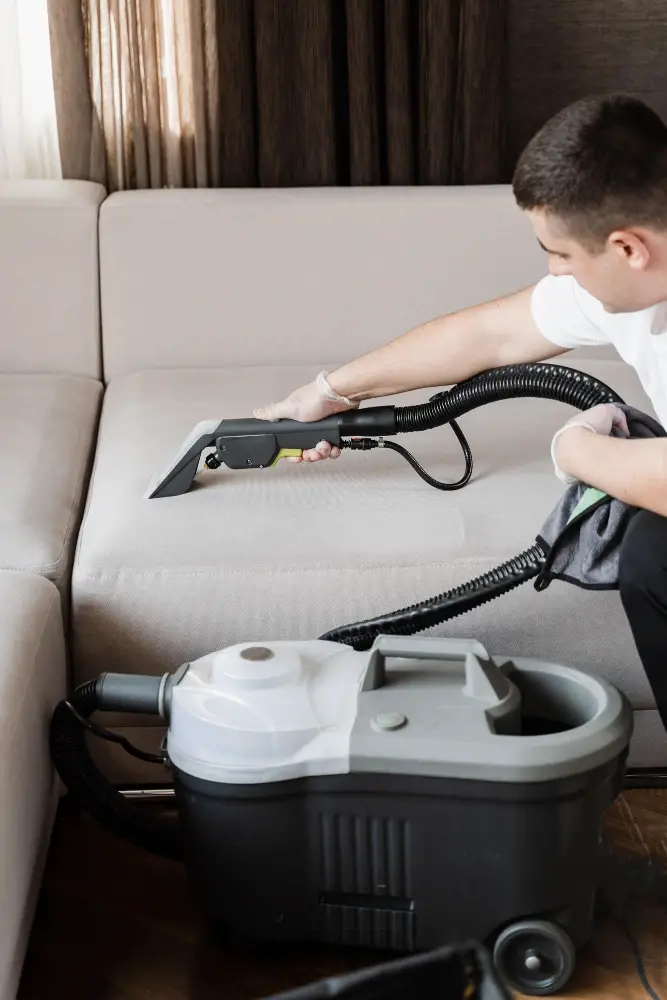
Professional cleaners have access to specialized equipment and products that can effectively remove even the toughest stains and odors from your couch. They also have extensive knowledge of different upholstery materials, so they know exactly how to clean each type without causing damage.
When choosing a professional cleaner, make sure to do your research beforehand. Look for companies with good reviews and ratings online, as well as those that are certified by industry organizations like the Institute of Inspection Cleaning and Restoration Certification (IICRC).
You should also ask about their pricing structure upfront so there are no surprises later on.
Couch Cover Use and Maintenance

They come in various materials such as cotton, polyester or microfiber and can be easily removed for washing. If you have children or pets at home who love to jump on the couch with their muddy paws or sticky fingers, then investing in a good quality cover is highly recommended.
To maintain your couch cover’s longevity and cleanliness, it’s important to follow the manufacturer’s instructions for care. Most covers can be machine washed on gentle cycle using mild detergent but make sure not to use bleach as it may damage the fabric fibers.
If you’re using a slipcover that doesn’t fit snugly over your sofa cushions then consider tucking them into place before covering them up – this will help prevent wrinkles from forming when someone sits down on top of them.
In addition to protecting against dirt and grime buildup over time by regularly washing your slipcovers every few weeks (or more often if needed), vacuuming underneath is also essential since dust mites thrive in warm environments like upholstery fabrics!
FAQ
How do you routinely clean a couch?
To routinely clean a couch, wipe it down with a clean, dry microfiber cloth, create a cleaning solution of equal parts water and white vinegar, dip another microfiber cloth into the damp solution, and wipe the couch, rinsing the cloth regularly.
What happens if you don’t clean your couch?
If you don’t clean your couch, it may accumulate dust mites, pet dander, allergens, and become dingy over time, affecting both hygiene and aesthetics.
Is it worth cleaning a sofa?
Yes, it is worth cleaning a sofa to remove embedded dander, sweat, and other unpleasant substances for healthier and refreshed upholstery.
How do you clean a couch weekly?
Weekly couch cleaning involves removing the cushions, vacuuming them thoroughly, spot treating stains, and using a fabric or brush attachment to vacuum the arms, back, cushion areas, and crevice tool for nooks and crannies.
What are the best methods for removing specific stains from a couch?
The best methods for removing specific stains from a couch involve using appropriate cleaning solutions, gentle blotting, and following fabric care guidelines.
How can you maintain the appearance and longevity of your couch through regular cleaning?
To maintain the appearance and longevity of your couch, regularly vacuum, spot-clean stains, and use upholstery cleaner as needed.
Are there any specific considerations for cleaning different materials, such as leather or suede couches?
Yes, cleaning leather and suede couches requires specific considerations such as using specific cleaning products and techniques for each material.




